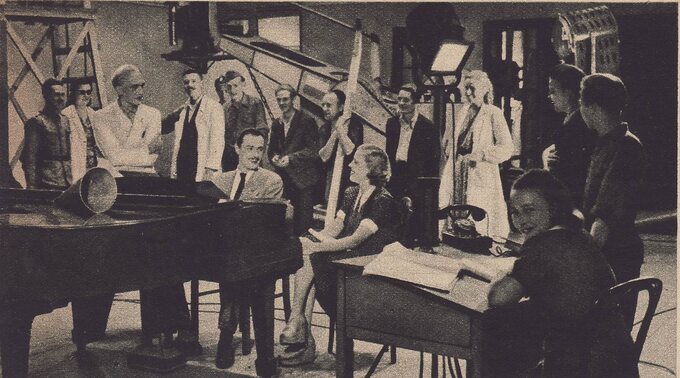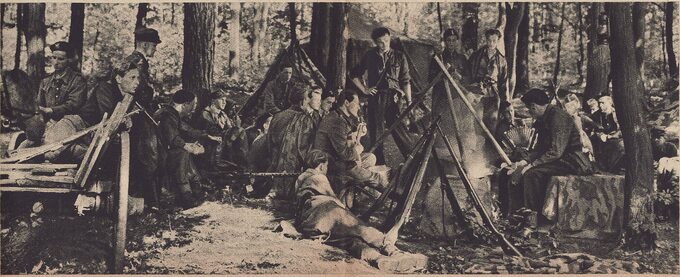Forbidden Songs, directed by Leonard Buczkowski, written by Ludwik Starski, is one of the most famous Polish films of all time. It was created shortly after the war. Exterior scenes were shot on the streets of Warsaw, which was destroyed after World War II, and the remaining parts in Łódź. People who survived the occupation took part in the film. Participating in Forbidden Songs, a film that some considered too light and frivolous in light of the tragedy of war, was a catharsis for others after their traumas. Many viewers had similar feelings.
History of Warsaw
The film “Forbidden Songs” starred Danuta Saflarska (as Halina Tokarska) and Jerzy Duszynski (her brother, Roman Tokarski). The film takes place in 1939-1945. The characters recall the time of the occupation, their work in the Polish subway, participation in combat operations (during one of the operations, Halina's beloved Rizard was killed), the Warsaw Uprising, the betrayal of a German informant, and the hiding of Jews. . The film has the character of a ballad, in which the characters recall and sing the songs that accompanied them in various moments of the German occupation, including in everyday situations.

Originally, the creators of “Forbidden Songs” did not plan that it would be a feature film. It was supposed to be more of a collection of 'Occupation' songs loosely linked together. However, as the work developed, new characters and threads emerged and the plot grew. This is how the first Polish post-war film was created.
“Forbidden songs” have two versions. In the first version (premiered on January 8, 1947), the main character Roman Tokarski tells the story of his life during the war to the employees of the film studio, who collect anti-German war songs. The film was very well received by the audience, but it was not liked by the authorities and many (often demanding) critics, especially Adam Vajik. The film was accused, among other things, of being shallow, of not conveying the horror of the war atmosphere, and of not emphasizing the role that the Red Army played in the “liberation” of Poland from German occupation. Then the filmmakers shot a second version (premiered on November 2, 1948), where Roman tells about his fate not to the filmmakers, but to his friends, including a repatriated friend who had just returned to Poland from England.
The film shows the fate of the people of Warsaw, their sorrows, but also their joys, but the most important part of the work is the titular “forbidden songs”. These songs were sung in houses and in the streets. Their words spoke of horror, but they also included fun and satirical songs – all of which offered comfort to war-weary Poles and strengthened the sense of unity in a nation that had experienced so much brutality. “Forbidden Songs” includes the following songs: “Heart in a Backpack” by Michal Zielinski, “Lets Are Falling from a Tree” by Vincent Paul, “Warsaw Huss” by Ludwik Starski, “The First Day of September in the Commemorative Year”. “, “When Midnight Struck on a September Night”, “Axe, Hoe, Ball, Cup”, “Red Apple”, “Now It's War Who Trades, Lives”, “The Weeping Willows Rumbled” and “Oh Whoah Whoah”. Importantly, that the disturbing songs sung by the Poles were contrasted with those sung by the German soldiers, including “Deutschland, Deutschland, über alles” and “Ein Heller und ein Batzen” (better known as “Heili, Hailo”).
Actors from Warsaw and Lodz theaters mainly participated in the film. Warsaw street musicians were also invited to participate. Some Germans were played by real German prisoners of war.
“I saw the film only at the premiere. I saw myself on the screen for the first time. It was a great experience. (…) Yurek (Dushinsky) and I were the happiest to finally be able to eat. Those were the times. On the first day of test photos, I was given scrambled eggs with a crunch. I will not forget this taste and my happiness (…). There was terrible poverty. In the film, we acted in personal clothes. I was later accused of deliberately wearing the same dress to show off. And I just had nothing to wear. In addition, rumor followed rumor (…). We were paid very little for this film. However, it was enough to survive. After “Treasure” (the film in 1948), for which I received a million, I could dress the whole family, because after the uprising no one had anything, Danuta Saflarska said years later in one of the interviews for “Film” (no. 05/2013). ).

Making the film, as you can see from the above statement, was not easy. The filmmakers lacked not only costumes, but also film supplies and equipment (they only had two cameras at first). All songs were pre-recorded. They played in the background on the set and the actors performed with playback. Despite all the difficulties, the film was released. The premiere took place on January 8, 1947 in the “Palladium” cinema in Warsaw.
Criticism
Both versions of the film were very well received by the audience. Danuta Saflarska became very popular after the premiere of the work and even appeared on the cover of the famous “Film” magazine (9-10, 1947).
Quite positive and favorable reviews appeared in such magazines as “Odpowiedzenie”, “Film”, “Kurier Polski” and “Dziennik Polski”. The critics of “Kuenica” presented a completely different approach. “Forbidden songs” were accused of “narrowing the reality of the occupation” and not being consistent with the reality of 1939-1945, or even “perverting the taste of the audience” and not presenting any artistic values. The same magazine also published the text of Adam Vajik, who had the most reservations about Butchkovski's work. According to Ważyk, the film did not present any interesting action, it was too episodic and poorly shot. Moreover, as Wazik wrote, this painting showed the time of the German occupation inappropriately and falsely, and did not carry any “historical specificity”.
Following this extremely unfavorable review, further, highly critical reviews of the film began to appear in subsequent newspapers. It was accused of “inciting outrage among ex-prisoners of Nazi concentration camps”, although it was not said who disliked the film so much.
Due to a number of critical comments, the makers of the film decided to produce a second version. According to some, including later reviewers, it was even good for “Forbidden Songs” as the film was enriched with new threads.
“Forbidden songs” also achieved success abroad. The film was screened in, among others, the USSR, Bulgaria, Czechoslovakia, Hungary, Israel, Romania, Albania, the USA, Finland, Iran, the Netherlands and Canada.
Also read:
Zbigniew Cybulski. The interrupted career of an unforgettable actorAlso read:
Pola Negri. The biggest Polish silent film starAlso read:
Great and cheerful Catholic Poland. A politically incorrect view of “1670”.
(tags translated)forbidden songs
